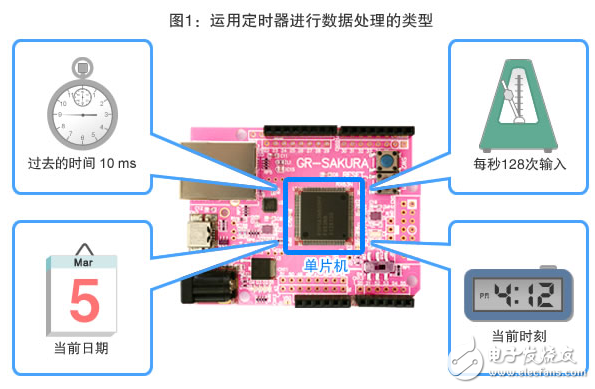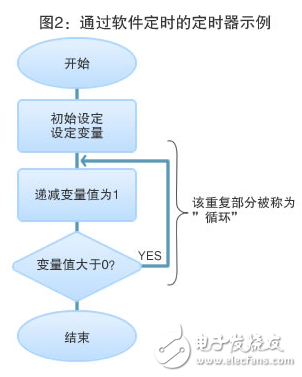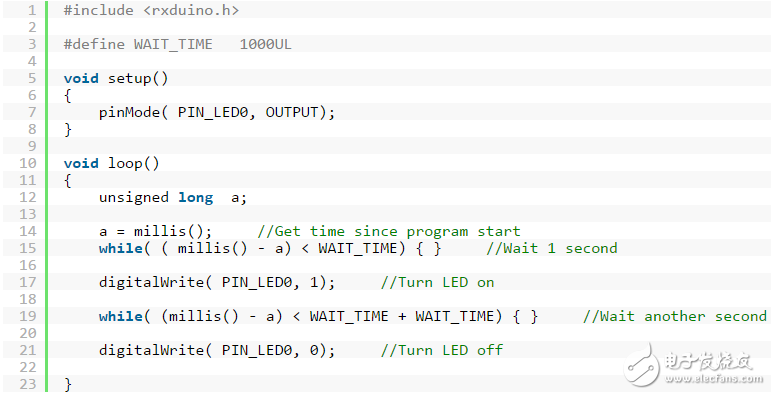In the previous issue of "Peripheral Functions Must Be Known by Microcontrollers - GPIO/Serial Communication" , we learned about the structure and usage of peripheral functions of the microcontroller. This article mainly introduces the timer interrupt function that the microcontroller must understand.
This serial will be described with the circuit board "GR-SAKURA" equipped with Renesas Electronics' RX63N as an example. Please try it out! Handle the processing of time and time in one hand!
In the single-chip microcomputer, not only the time display such as "â—‹â—‹â—‹â—‹â—‹â—‹â—‹â—‹" is frequently used, but the past time and a certain period are also frequently used. For example, "How long has the program passed since the start of the operation?", "Transmission of 128 signals per second" and so on. In addition, it is often used in the case of "waiting for a specified time" and "moving to the next processing after a specified time has elapsed". The peripheral functions that are handled in relation to time and time are the timers (Figure 1).

Instead of using a timer for peripheral functions (hardware), we can calculate the time by software. An example of timing using software will be described below with reference to Fig. 2, which assumes that the processing of the loop (repetition) portion takes 1 μs (microseconds: 1 millionth of a second). From this, it can be calculated that it takes 1 ms (milliseconds: one thousandth of a second) to repeat the cycle for 1000 times, and it takes 1 second to repeat 1 million times. That is: the time is calculated by "waiting for the time specified by the loop processing". However, the CPU will concentrate on the processing of the time calculation and cannot perform other processing. Moreover, only one cycle of time can be calculated. In reality, the MCU needs to correspond to various cycles of 0.1 second and 1/1024 seconds.
In addition, the CPU's timer frequency (drive speed) will also have an impact on the software. If you change the 100MHz drive CPU to 50MHz, the time required to cycle once will be twice as long. Therefore, it is necessary to correct the software for calculating the time. As mentioned above, since it takes time and error in management, it is extremely difficult to avoid calculating time by software.

Slightly introduce the contents of the interruption...
Below, we briefly introduce the technology that is inseparable from the timer - "interrupt function". The "interrupt function" in a single-chip microcomputer refers to a request for "starting other processing" for some reason during the execution of a program. Since the interrupt function can be used, the CPU can be made to concentrate on one process.
Let's imagine the use of the "interruption function" in daily life. When we pour hot water into the instant noodle box, if we keep staring at the clock for 3 minutes, then we can't do other things during this time. thing. But if you set the kitchen timer for 3 minutes, we can do other things before the kitchen timer alarm sounds. In this example, "always staring at the clock" is equivalent to the "waiting for the time specified by the loop processing" described in the previous section, so you can't do anything else until the end of the process. At the same time, the kitchen timer alarm is equivalent to the interrupt function. You can do other things before the interruption occurs.
There are various timers in the peripheral functions of the microcontroller. These timers send interrupt signals to the CPU at the specified time or at the end of processing. Not only are timers, but many peripheral functions transfer interrupt information to the CPU at the time of "change" and "process start/end". Therefore, the CPU can continue to do other work before the interrupt function occurs, thereby improving the work efficiency. The details of the interrupt function will be described in detail in the fourth issue of the external interrupt function IRQ. In this issue, we first know in advance the content of “transferring information from the peripheral function to the CPU in the form of an interruptâ€.
Among the various timers, there is also a "watchdog timer"!
Among the peripheral functions of the microcontroller, the most intimate timer is a timer that calculates the specified time and a timer that interrupts at regular intervals. In addition, Renesas Electronics' RX63N MCU is equipped with a timer for generating a pulse width modulation/demodulation (PWM) signal for controlling the servo motor, a timer for calculating the input signal interval, and an RTC (Real Time Clock) for displaying the current time. A variety of timers.
Among the timers, the most distinctive one is the WDT (Watchdog Timer). The watch dog in its name Watch Dog TIme means "watchdog", its job is to monitor the program for out of control. The program monitored by the WDT is started by writing the set value to the WDT in advance. The WDT subtracts the written value at regular intervals. When the program runs normally, the WDT is cleared and then terminated before the processing ends. However, if the program is out of control (into an unexpected repetitive state and cannot be stopped), the value written to the WDT will be less than 0 (called underflow), thus notifying the CPU that the program has run out of control. In an important system that does not allow sleep, the "watchdog timer" - WDT installed in the microcontroller plays an extremely important role.
Try to use the timer easily
Although it says: "We actually use the timer through the program...", but in fact, in order to be proficient in using the timer, you must first understand the operating steps of the microcontroller. Moreover, it is necessary to understand not only the steps of operating through software, but also the hardware (structure) of the microcontroller and the specifications of the components used.
Therefore, please use the "database" when you need help. For the GR-SAKURA board equipped with the RX63N microcontroller, we have prepared several databases related to time and time.
Sketch parameters of SAKURA: Sakura library time (English only)
In this program, the LED on the GR-SAKURA is illuminated in a certain period. Although it is only a very simple operation, it is necessary to use a timer in order for the LED to emit light in the correct cycle. In the "Time" option of the above cherry blossom library, there is a database for calculating the elapsed time, so we use it.
The program is shown in Figure 3. The millis function on line 14 is sent back in milliseconds (milliseconds: one thousandth of a second) from the start of the program, with no parameters. Using this function, the result after 1 second and 2 seconds was obtained by obtaining the difference from the initial measurement (line 14). The loop is generated with the while language, waiting for 1 or 2 seconds from the value of a (line 15, line 19). Thus, LED0 (D1 of the GR-Sakura board) lights up after 1 second, and turns off after 2 seconds. The loop function ends when the light is off, but the operation continues again and again. In addition, the millis function has no symbol and will return a long integer.
Figure 3: Program that uses the timer function to turn the LED on. In this example, it flashes in a cycle of 1 second.

※//~ is used for evaluation and does not affect the execution of the program.
Enter the program into the Web compiler and transfer the compiled binary to GR-SAKURA. After the transfer is completed, the four LEDs will be temporarily turned off before starting execution, and LED0 (D1 of the GR-Sakura board) starts flashing.
Let us explain one of the necessary peripheral functions "timer". The processing of time and time is required in all kinds of occasions. Please take this opportunity to actually operate various databases.
However, the numbers "128 times of leap seconds" and "1/1024 seconds" suddenly appear in the text. Did you surprise you? 128 is the 7th power of 2, and 1024 is the 10th power of 2. The RTC has the ability to generate an interrupt every 1/128th of a second... This is a number that is often seen in the world of microcontrollers.
SMT Motor
SMT Motor, original and new ,in stock, quality gaurantee.
SMT motor : actuator motor,servo motor, converyor motor,rail motor, bom stepping motor, rizing motor, Z camera motor, Y camera motor, X camera motor.
Smt Motors
Smt Juki Motors
Original Smt Servo Motor
Original Smt Motors
Holder For Smt Type
Smt Battery Holder
SMT Holder
Battery Holder
Filter For Smt Machine
High Quality Smt Filter
Smt Filter
Smt Machine Filter
Smt Tape Feeder Parts
Feeder Parts For Smt Machine
Smt Machine Spare Parts
Original SMT Feeder
Original SMT Cable
Smt Machine Cable
Smt Spare Parts Fuji Cable
Smt Cable
SMT Belt
Smt Siemens Belt
Smt Juki Belt
Smt Conveyor Belt
Smt Camera
Smt Laser
Camera For Smt
Smt Siemens Camera
Smt Parts Plastic Rail
Smt Plastic Rail
Smt Juki Plastic Rail
Juki Plastic Rail
SMT Nozzle For Yamaha
Yamaha Nozzle
Nozzles For Yamaha Machine
Smt Yamaha Nozzle
Smt SIEMENS Nozzle
Nozzles For Siemens Machine
Smt Nozzle For Siemens
Siemens Nozzle
Smt Nozzle For Samsung
Nozzles For Samsung Machine
Smt Samsung Nozzle
Panasonic Nozzle
Smt Panasonic Nozzle
Smt Nozzle For Panasonics
Nozzles For Panasonic Machine
Smt Juki Nozzle
Nozzles For Juki Machine
Juki Nozzle
High Pressure Juki Nozzle
I-Pulse Nozzle
High Pressure I-pulse Nozzle
Nozzles For I-pulsemachine
Smt I-pulse Nozzle
High Pressure FUJI Nozzle
Nozzles For Fuji Machine
Fuji Nozzle
Smt Fuji Nozzle
Smt Nozzle
Smt Parts Nozzle
Smt Nozzle For Machine
Smt Spare Parts Nozzle
Yamaha Smt Feeder
YAMAHA Feeder
Smt Machineyamahafeeder
Smt Feeder For Yamaha
Smt Feeder For Siemens
Smt Machine SIEMENS Feeder
Siemens Smt Feeder
Siemens Feeder
Samsung Smt Feeder
Smt Machine SAMSUNG Feeder
Samsung Feeder
Smt Feeder For Samsung
Panasonic Smt Feeder
Panasonic Feeder
Smt Machine Panasonic Feeder
Smt Feeder For Panasonic
Smt Feeder For Juki
JUKI Feeder
Juki Smt Feeder
Smt Machine Juki Feeder
I-Pulse Feeder
Smt I-pulse Feeder
Smt Parts I-pulse Feeder
I-pulse Type Feeder
Pneumatic Feeder
FUJI Feeder
Smt Fuji Feeder
Fuji Smt Tape Feeder
Smt Machine Feeder
Smt Tape Feeder
Smt Feeder
Feeder For Smt Machine
Siemens Control Valves
Smt Siemens Valve
Siemens Vacuum Valve
Siemens Valves
Smt SAMSUNG Valve
Samsung Vacuum Valve
Samsung Control Valves
Samsung Valve
Juki Vacuum Valve
Juki Ejector
Juki Vacuum Ejector
Juki Valve
Smt Motors,Original Smt Motors,Smt Juki Motors,Original Smt Servo Motor
Shenzhen Srisung Technology Co.,Limited , https://www.sr-smts.com
